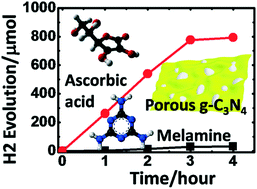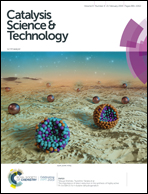In situ reduction and exfoliation of g-C3N4 nanosheets with copious active sites via a thermal approach for effective water splitting†
Abstract
Poor optical absorbance and charge recombination are the major drawbacks of polymeric graphitic carbon nitride (g-C3N4)-based photocatalysts. In this paper, we show for the first time a single-step in situ technique to control the porosity of two-dimensional g-C3N4 sheets and exfoliate them by introducing ascorbic acid (AA) molecules. The AA simultaneously acts as the carbon (C) source and deposits amorphous C onto g-C3N4 sheets. Nanosized pores are also introduced into the g-C3N4 sheets, leading to a large number of active sites. The as-prepared C-doped porous g-C3N4 nanosheets demonstrate a high visible light-photocatalytic H2 production activity of 793 μmol g−1 with the optimum structure, which is almost 25 times higher than the value obtained with bulk g-C3N4 (31 μmol g−1). This exceptional photocatalytic performance arises from the C-doped conjugated system and porous nanosheets. The enhanced photocatalytic H2 evolution was attributed to the effective separation and transport of charge carriers by the deposition of C onto the nanosheets and an increased number of active sites resulting from the nanopores created inside the g-C3N4 sheets. Moreover, molecular dynamics (MD) simulations confirm that the interaction between AA and melamine molecules at elevated temperatures results in the formation of C-doped porous and exfoliated g-C3N4 structures. Therefore, the present approach is very promising for application to the design of new and efficient photocatalysts for photocatalytic H2 evolution under visible irradiation.



 Please wait while we load your content...
Please wait while we load your content...